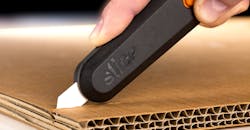Many industrial companies are considering switching from metal-blade cutting tools to ceramic-blade cutting tools as the latter become more available and more popular.
Unfortunately, hasty web research is likely to turn up information that lumps all ceramic blades together, when in truth they are not all created equal. Misinformation and false claims abound.
The truth is, Slice® is the only manufacturer that makes a truly safer blade. Our grind is safe to the touch, and it’s proprietary. But there’s more to know.
Ceramic Blade Materials Differ
Slice ceramic blades, whether it be our utility blades or box cutter blades, are made of 100 percent zirconium oxide, also known as advanced ceramics or engineered ceramics.
Many other manufacturers of ceramic blades use fillers to create a more flexible blade or to lower the price. These products will not offer the great benefits associated with blades made of pure zirconium.
One-hundred-percent zirconium blades feature these favorable properties. They are:
- Extremely hard
- Rust free
- Non-conducting
- Non-sparking
- Non-magnetic
- Maintenance free, requiring no oil coating
- Safe to 1600 degrees Celsius
- Chemically inert
Hard Doesn’t Mean Sharp
Ceramic blades that are made of 100 percent zirconium are much harder than steel, the most common metal blade material. This means that these ceramic blades can last longer.
Slice takes advantage of this hardness with our patent-pending blade grind. Our blades have been tested by an independent third party and found to last up to eleven times longer than their steel counterparts.
The longevity of Slice blades is excellent news for anyone looking for non-magnetic and non-sparking cutting tools. Copper, bronze, or brass alloys are typically used for cutters that need to be non-sparking, and these metals are all softer than steel. They are notorious for wearing out quickly.
Hardness, however, is not linked to sharpness. This is a fact we have seen others claim, and it simply isn’t true. Sharpness is determined by how the manufacturer grinds the material.
Sharpness is often associated with ceramic blades because many ceramic kitchen knives are extremely sharp in order to cut smoothly through soft meats, like fish. Unfortunately, such a fine edge risks chipping and shattering, making kitchen ceramics less durable.
Slice ceramic blades, on the other hand, will almost feel dull to the touch compared to the razor-sharp blades we’re used to. This doesn’t affect their cutting power, though.
The reason metal blades are sharpened to an unsafe level is to extend their working life. Metal blades dull so quickly that, if they started at an effective and safe sharpness, they would almost immediately become too dull to use. Other ceramic blade manufacturers mimic this dangerously sharp grind. Slice blades aren’t sharper than traditional blades, but they are effective and they last longer.
Ceramic vs. Steel: Which Is Best for Industrial Use? And for Kitchen Use?
There have been claims that ceramic blades are better for kitchen use while steel is better for industrial purposes. This is misleading. It depends on what the tool is designed to do.
Slice blades, like our utility blades, are specifically designed to be used in an industrial setting, and to make the cutting experience safer. Our many industrial customers—including over half of the Fortune 1000 companies—attest that Slice cutters, like our utility knife, work well, are long-lasting, and help their staff stay safer. And Slice blades have proven to be as versatile as other blades.
Different purposes require different blade designs, and that results in different blade properties. It’s worth repeating: ceramic blades are not all equal.
Brittle and Fragile Isn’t a Property of All Ceramic Blades
The first advanced ceramic blades were made for kitchen use, and their thin, extra-sharp grind led to the misconception that all advanced ceramic blades are brittle—that is, prone to chipping and shattering. We’ve even seen the claim that this fragility is particularly true when it comes to blades used in cutters for industrial environments, like utility knives.
Experience has shown us that this is not necessarily true. Yes, zirconium oxide is more brittle than steel. But that’s not the end of the story. The usability of advanced ceramic blades is determined by how the blade is designed.
Again, a thin ceramic blade with an extra-sharp grind will be more fragile than an equally thin, razor-sharp metal blade. Slice blades are thicker and feature a safer grind. This makes cutters like our safety utility knife safe and long-lasting.
Not All Ceramic-Blade Cutter Handles Are Created Equal Either
Cutting tools aren’t just about the blade, of course. While we encourage people to understand that not all ceramic blades are the same, it’s also important to recognize that every industrial safety knife isn’t the same either. For instance, we looked at every design aspect of the standard box cutter and improved its safety and ergonomics.
Safety has always been a key driver in all of our efforts, which is why we also publish a weekly Workplace Safety Blog on the Slice website. However, we haven’t just rethought every aspect of blade design to create a safe variety of retractable knives; we also apply this diligence to making sure our tools are durable and ergonomic.
All said, one fact is certain: you won’t find any other blades—ceramic or otherwise—that earn the moniker “safety blade” the way Slice blades do.

